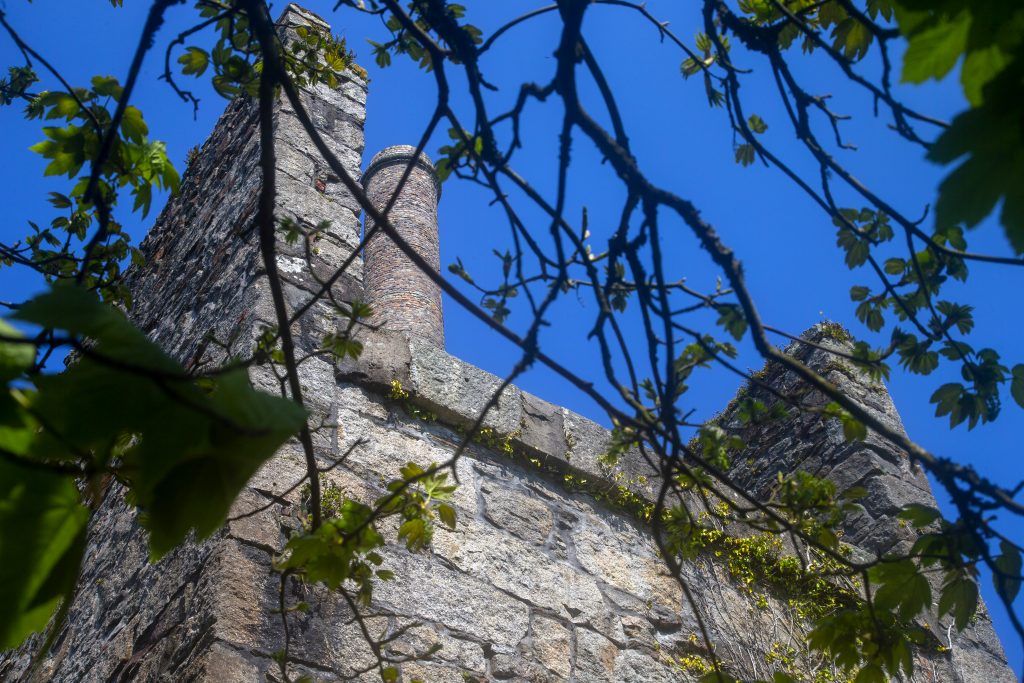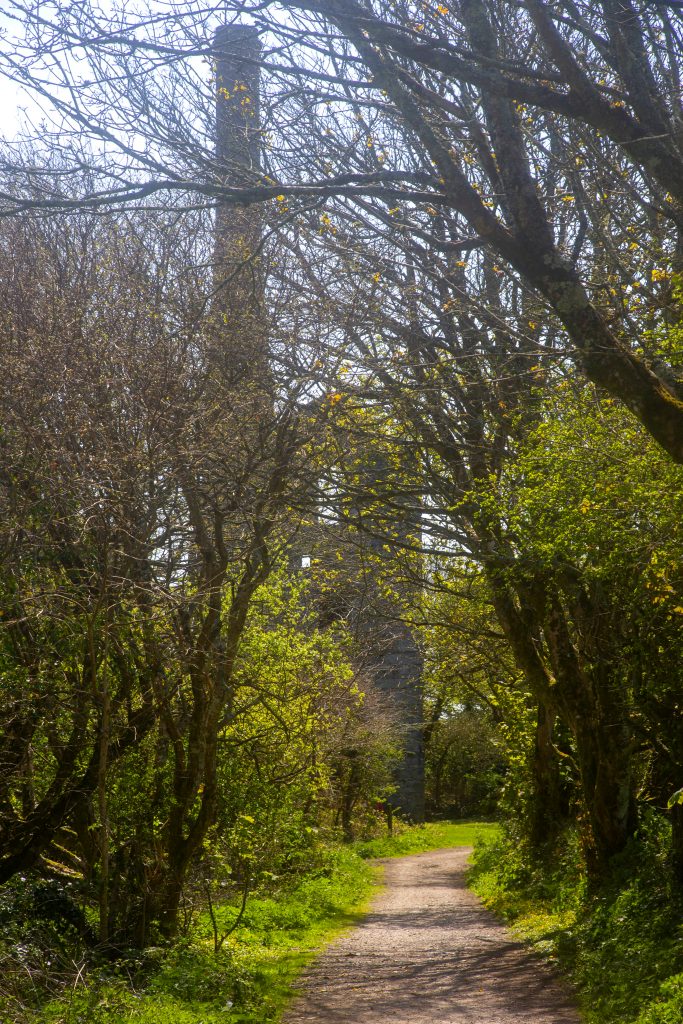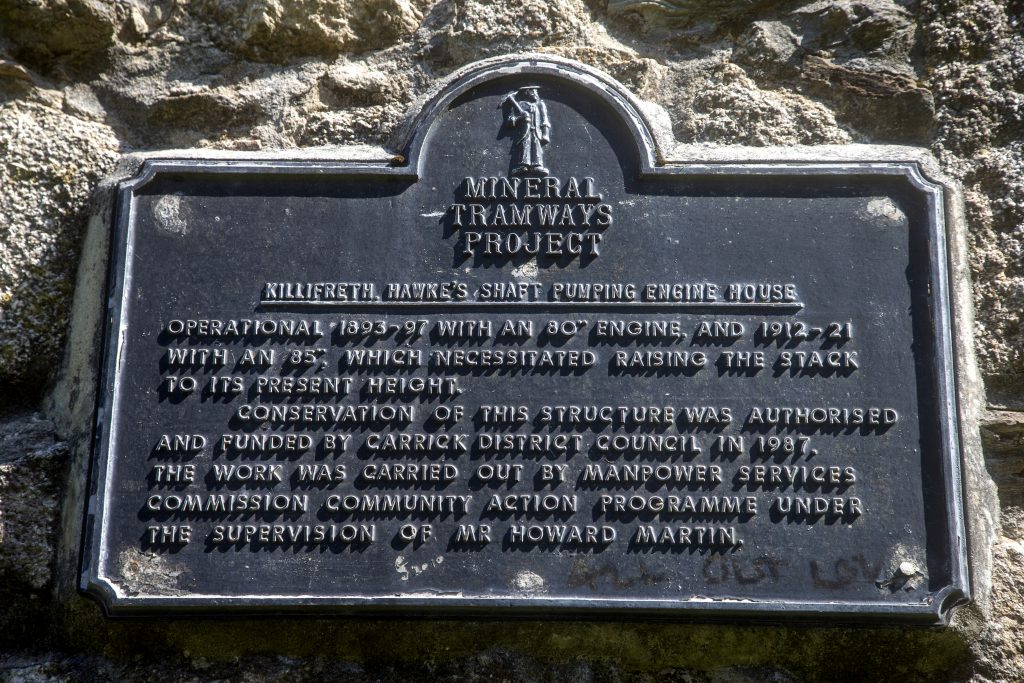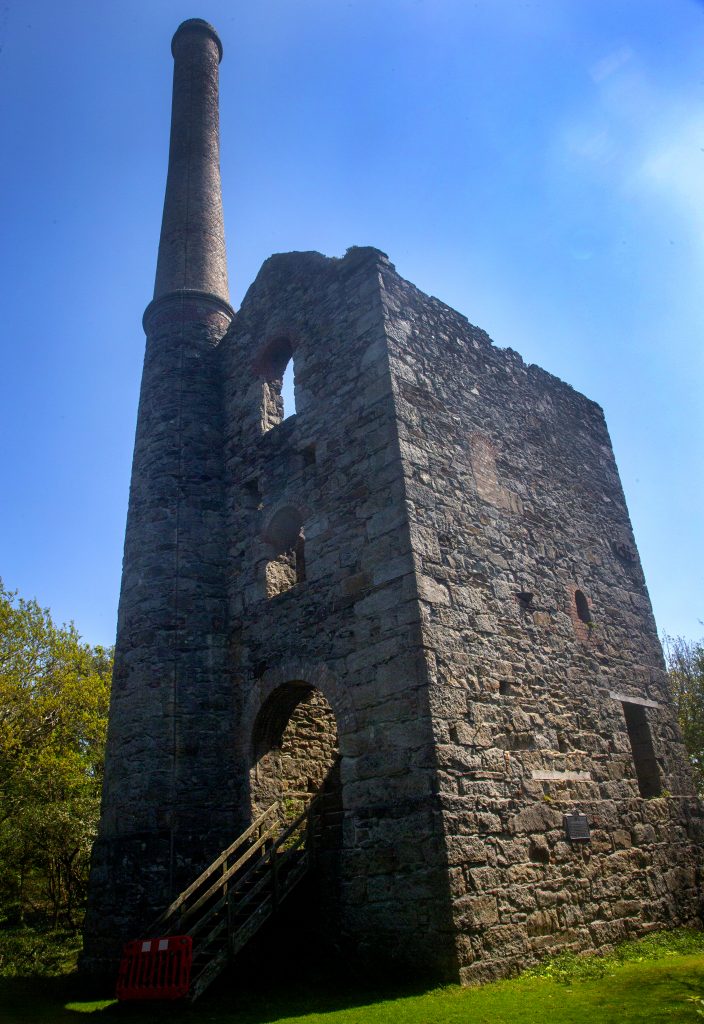The mining region of West Cornwall is noted for its impressive engine houses, although none of these great buildings is more famous for its elegance than that at Hawkes Shaft, Killifreth. Hawkes engine house was erected in 1893 to house an 80-inch pumping engine, and when the mine re-opened, in 1912, the building had to be modified to accommodate an 85-inch engine. The high, tapering chimney stack dates from that period, when it was deemed that the extra height (it is 100 feet high), would improve the draught. Jack Trounson thought that it was a mistaken belief. Beneath the fields and woods at Killifreth lie fairly extensive workings of what was a medium-size nineteenth century Cornish tin mine. Killifreth mine was a thousand feet deep, worked four lodes, none of which were especially rich, all of them fairly narrow, and left behind mine waste burrows of no great extent. The mine worked quite successfully for almost forty of the most difficult years of Cornish mining history. Killifreth never joined the top twenty tin producers in Cornwall but jogged along as an average tin mine of the second half of the nineteenth century. At its peak, in the early 1890s, the mine possessed 50-inch and 80-inch pumping engines, a 22-inch whim engine which also operated flat rods, and a 32-inch stamps engine. There was also one of the first “safety cages” to be used in a Cornish mine in Hawkes Shaft. At that time the mine employed 281 workers, far fewer than its large neighbours, Wheal Busy, Poldice, United and Consolidated in their hey days. Its production never rivalled that of the principal mines of the district, but it was far more typical of Cornish mines than those large and famous mines.

Mining at Killifreth began in Medieval times, and when the earliest extant records of mining there began, at the beginning of the sixteenth century, the industry was well-established. A will of Thomas Tregian, dated 1517, refers to a mine called “Whelle Yeste in Kyllvrethe Downe”, and another document, dated 1523, mentions mining at Killifreth, Creegbrawse, Coyschase and Saveock. In 1585 the importance of the tin close to the surface in the woods was emphasised with the words: “The woods of Kilyvregh muste be viewed I thinke… the tynn there must be consyderyd.” Killifreth Woods are dotted with small, ancient shafts, adits and openworks, testimony to that remote min-ing period. These workings, accessible until recently from a score of small, narrow shafts, show how easily obtainable tin must have been at that time. Large cassiterite crystals were a feature of the workings, and good examples have been found in recent years.

Killifreth was the scene of violence in 1517, when Phillipa Carminowe, a widow, and her servants, were driven from her house by a gang led by the local Kenwyn Constable and his supporters. Constable Stephen Langhar was an extremely violent man, and on another occasion, he had stabbed to death a man who refused to assist him in his duties. He had fled to Padstow for sanctuary, and only returned when the fuss had died down. At Killifreth he appeared to be acting for local businessmen, Thomas and John Tregian, who intended to take Killifreth by force from Mrs. Carminowe. Langhar, his brother and the Tregians assembled a large gang of well-armed men, who marched from Truro to Killifreth and attacked the lady and her servants who, according to her, barely escaped with their lives. It could be that the valuable tinworks at Killifreth were part of the attraction for the Tregians. As the 1517 will (above) was that of Thomas Tregian, it seems not only did he gain possession of Killifreth through his murderous attack, but that the mines there were an important part of his new property.
Killifreth Downs occupied the area between the river which runs through Chacewater and the old parish boundary on the west and south-west side of the woods. It included all of what we now call Wheal Busy and Wheal Daniell, and as far south as Wheal Bush. Starting in 1615, when “Pitte Cassane” and “Pitte Lawarne”, both in what became Wheal Busy, were registered, there is a continuous record of tinbound records for Killifreth Downs. Three families in particular were prominent owners of these tinworks: Harris, Buckingham and Daniells. Among the small mines operating were “Wheek an Buckett”, “Greegbare”, “Wheel an Bush Vean”, “Pit Caser” (Cassane), “Weele Good Lucke”, “Wheale an Dayet”, “out of dept” (debt) and “Mettle Worke”. Altogether some eleven mine bounds were registered on the downs.

By the end of the eighteenth-century part of the area was becoming known as Chacewater Bal, and occasionally as “Pitscassowe Downs”. By then up-country copper entrepreneurs, like John Coster, were becoming interested in the rich and plentiful copper ore at Chacewater, and the area had been examined by the agents for the new copper smelter at Polruan, near St Austell. Suddenly, in the decades between 1690 and 1710, the whole of the Cornish mining industry had switched its centuries-old preoccupation with the white metal to the red, and copper was replac-ing tin as the all-important metal mined here.
At Killifreth, tin remained important however, and although copper grew in importance as the mines deepened, tin remained as the principal product of the northern section of the mine. The main period of activity, and the period from which most records have survived, is the second half of the nineteenth century. During the early years of the century the woods were worked under the name Wheal Union and North Wheal Unity, and Wheal Vor Lode was worked from Wheal Busy. In about 1858, the name Killifreth Mine was probably used for the first time, and during the next ten years the mine which was centred on Old Sump, New Shaft and Richards (Hawkes) shafts was opened up as an integrated unit. The Great County Adit, which had a branch close to the northern workings on Wheal Vor Lode, was driven northwards from North Wheal Unity to Old Sump Shaft and on past Richards Shaft. Thomas Spargo’s description of Killifreth Mine in 1865, says: Killifreth, in Kenwvn, in 1,000 shares. Purser, Mr Edward Hawke Jun., Tregullow. Manager, Captain John Tremayne, Wheal Rose, Scorrier. Lord. Viscount Falmouth. Dues, I -20th. Depth of adit, 43 fathoms. Depth under it, 30 fathoms. 30 employed. Pumping-engine, 12-inch (rotary). Rocks, clay-slate and alvan. No returns in 1864.
The Company have very recently resumed the works, which were suspended a year or two. They are sinking the engine-shaft, which will intersect the lode at about 70 fathoms. There are numerous lodes in the sett, which appears to warrant extensive exploration. Great Wheal Busy lies contiguous to the mine to the east, and Wheal Unity Wood, formerly rich, at the west.
The new company continued until 1896, when it converted to limited liability to gain more capital. In the 33 years of its existence, the company weathered many crises, almost succumbing to the various collapse in the tin price which beset Cornish mining in the second half of the nineteenth century. An example of the rapidly changing fortunes of the time can be seen in the period 1870 to 1874. In 1872 there was a sudden price boom, which led to the re-opening of many small, marginal mines, followed by an almost total collapse in 1874, which very nearly destroyed much of the industry. Killifreth’s tin revenue was halved in a matter of weeks.
Over the years from 1858 Killifreth has its share of interesting and colourful characters. In 1879 Capt. John Michell became agent and then manager, remaining at the mine till his death in 1893. Michell had the reputation for being a thorough and well-organised manager and was a factor in the mine’s survival during the years of crisis. In 1881 Capt. Joe Tamblyn became under-ground agent. Tamblyn was a high-flyer, who had worked in Italy, Wisconsin and South Africa. After Killifreth, he worked at Basset Mines, South Wheal Crofty, Dolcoath, Spain, East Pool and Condurrow, where he became manager. He was replaced in 1887 at Killifreth by Capt. Oliver Northey, whose family has been connected with County Adit maintenance for generations. Purser Tregonning was also quite a character, and the letter books which detail his negotiations with Lord Falmouth’s agent to get a reduction in tin dues make very amusing reading. He was not averse to making pleas in crowded Truro Streets where he thought it appropriate.

A famous, or infamous, character was Capt. R A James, who became a junior mine captain to Killifreth in the early 1890s. He was certainly no ordinary miner. He went underground in a mine to the west of Camborne as a young lad, was sent by his father to learn about founding at Hayle, went to America as a young man to mine, and travelled the west in the most adventurous circumstances. He had countless exciting adventures in the mining camps of the west, working underground and at surface, before becoming a shareholder and then owner of the North Star Gold and Silver Mine, in Colorado. He made a fortune there, moved west by stagecoach, was held up by gangsters at gunpoint, and he trekked in snowshoes over Rocky Mountain passes at heights in excess of 13,000 feet. Eventually, after years of dicing with death, he returned home to Cornwall with his packets full of gold, eager to invest in a Cornish mine. Once mine manager, James introduced the American shift-boss system at Killifreth, successfully re-introduced tributers into low payability stopes, introduced the “Yankee machine” – a safety cage – into Hawkes Shaft, and generally espoused the “big is beautiful” concept. His big change, many say his big mistake, was to change the mine from cost book into limited liability company. The Mining Journal blamed the rash introduction of limited liability for the mine’s closure in October 1897. After that, for a short time, the mine became part of Truro School of Mines. Killifreth’s technological development was interesting, and following the 1860s, when the 12-inch pumping engine represented the total power of its machinery, the mine gradually increased its investment in appropriate gear. 1873 saw the purchase of a second-hand 50-inch pumping engine from Wheal Daniell. It cost the mine £1,300, and the price included an eleven-ton boiler. In 1876 the mine bought a 32-inch stamps engine for £560, the price including buddies, two 16-head stamps exles and other dressing plant. Eventually, the engine cylinder was increased to 36-inch, and another 32 heads of stamps were added to the plant. 1891 it was decided to increase pumping capacity, and an 80-inch engine was bought from north Treskerby for £575. The engine was already over 30 years old, but it came with balance bob, main rods, whim, capstan, wire rope and all of the gear. In 1912, during yet another mini-boom in Cornish mining, and 85-inch engine was purchased for Hawkes Shaft.

Killifreth did not survive the problems brought by the Great War. After the conflict the mine worked in conjunction with Wheal Busy, but by the end of the 1920s both of these mines were officially closed, although some informal tributing continued in both mines at least until the Second World War.
American engineers occupied Wheal Busy after 1942, and they blew up two engines at Killifreth, for explosives practice. The 22-inch whim and the 85-inch Hawkes engine were both destroyed. In recent years, whilst work was carried out on Hawkes engine-house to stabilise the structure, pieces of metal work, blasted by the Americans into the stone walls, were found and removed by the labourers.
Killifreth now occupies a beautiful site. The woods are peaceful, wild and unspoilt. The place has atmosphere. The engine-house ruins are still impressive, and the whole mine site carries fascinating evidence of mining over the last five-hundred years. It is a place which needs no management by outside “funding”, D.L.G. or otherwise, If it is to be on the Mineral Tramway route let it be left as it is, unspoilt and original, without “idiot boards” or “tarted-up” paths, but just as it has evolved since the closure of those mines so long ago.